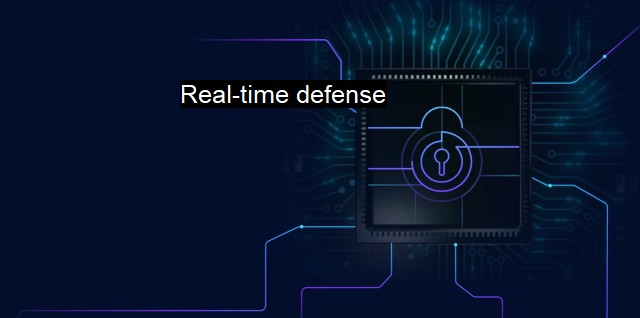What is Real-time defense?
Staying Ahead of Cyber Threats: The Crucial Role of Real-Time Defense in Modern Cybersecurity Systems
Real-time defense is a critical component of modern cybersecurity systems, especially in the case of antivirus programs. It refers to a system's ability to identify and respond to threats in real-time, without delay or interruption. Real-time defense relies on cutting-edge technologies, including machine learning, artificial intelligence, and behavioral analysis to detect and mitigate threats rapidly.The importance of real-time defense can be understood in the context of the ever-increasing sophistication of cyber-attacks. As cybercriminals develop and deploy new strategies and tools to infiltrate computer networks and extract valuable data, software developers must also adapt their protection efforts to counter these advances. One of the most significant losses that can result from a successful cyber-attack is monetary harm, which alone not only infiltrates organization's and individuals assets but also their reputation and credibility.
For this reason, a robust and effective cybersecurity system can protect against harmful malware, intrusion detection, ransomware, phishing attacks, identity theft, among others.
Real-time defense goes beyond traditional, static antivirus scans, which rely on a pre-existing database of known threats. These databases contain definitions of malware, viruses, and other illicit software. Their coverage area is usually vast, including malware signatures, heuristics, and static analysis, and more recently, behavioral analysis. Once the system detects a harmful file, it can block it and remove it from the user's device. In their most recent versions, these antivirus protection software tools comprise a diverse range of prevention features involving troubleshooting, increasing performance optimization for programs, intuitive features, and support for a vast range of operating systems.
cybercriminals constantly develop and deploy new methods to infiltrate systems, and although keeping on hand a large and versatile database is necessary, there is an ever-growing threat of unknown files. Solutions to contextual analysis and determining their fact within a cybersecurity threat are improving rapidly.
Real-time defense goes alongside with the powerful concept of dynamic signature writing, where it includes recognizing patterns surrounding factors such as blocked IP, cancelled SSL connections, among others, creating agility and improvisation to determining unseen patterns. It consists off combining file binary similarities, creation and usage time, language analysis filtering and behavioral audits to estimate the probability of belonging to a malware category file with a high level of precision.
correlation with information focused on technology such as changes to configuration files updated co-dependencies, registry swapping, and DLL injecting provide an increasingly precise precision score to detect. This advancement increases network security and addresses one of the most significant challenges cybersecurity threats present.
applying real-time defense is central to protect network security. Due to ever-emergent sophisticated approaches for hackers, signature databases alone are not enough. Cybersecurity requires acute analysis to such as behavioric tendencies, adaption accuracy to different malware or the rapidly supplementing features in operating systems, sorting variables to deliver results closer to network, servers and individual users. Protecting networks (works and individuals) vs external events generated due to cybercrime results in returns in monetary value and invaluable credibility in award damage prevention.

Real-time defense FAQs
What is real-time defense and how does it differ from traditional antivirus?
Real-time defense is a cybersecurity method that constantly monitors and analyzes system activity to detect and prevent threats in real-time. Traditional antivirus software only scans for known threats and may miss newly emerging threats or zero-day attacks. Real-time defense provides a proactive approach to cybersecurity by actively analyzing all incoming and outgoing traffic to identify and block any suspicious activity.What are the benefits of using real-time defense?
The benefits of using real-time defense include enhanced protection against both known and unknown threats, proactive defense against zero-day attacks, and reduced risk of data breaches and cyberattacks. Additionally, real-time defense provides real-time alerts that indicate potential threats, allowing for quick response and remediation.How does real-time defense impact system performance?
Real-time defense may have a small impact on system performance as it constantly monitors and analyzes system activity. However, the impact is typically minimal and unnoticeable to the user. Real-time defense software is designed to use minimal system resources and ensure that system performance is not impacted.Can real-time defense work as a standalone cybersecurity solution?
Real-time defense can be used as a standalone cybersecurity solution, but it is recommended to use it in conjunction with other cybersecurity measures, such as firewalls, intrusion detection systems, and endpoint protection. Real-time defense provides comprehensive protection against threats, but a layered defense approach is always recommended to ensure maximum protection and prevent any gaps in security.| | A | | | B | | | C | | | D | | | E | | | F | | | G | | | H | | | I | | | J | | | K | | | L | | | M | |
| | N | | | O | | | P | | | Q | | | R | | | S | | | T | | | U | | | V | | | W | | | X | | | Y | | | Z | |
| | 1 | | | 2 | | | 3 | | | 4 | | | 7 | | | 8 | | |||||||